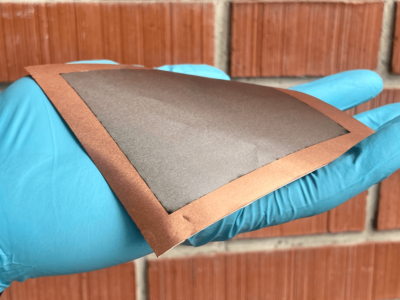
Atoms-thick MoS2 rectenna converts Wi-Fi signals into electricity
The diode was then put to good use to rectify random high-frequency WiFi signals into DC electricity. The MoS2 rectenna is ultra-thin and flexible, and could be fabricated in a roll-to-roll process to cover very large areas, making up for its relatively low efficiency compared to proven silicon-based rectennas, the researchers anticipate.

battery-free “rectenna” converts energy from Wi-Fi
signals into electricity. Image: Christine Daniloff
The rectenna described in Nature consists of a flexible RF antenna that captures electromagnetic waves and passes on the AC signal to the MoS2 Schottky diode which converts it into a DC voltage. Such a rectenna could passively captures and transforms ubiquitous Wi-Fi signals into useful DC power for battery-free devices, or it could be made into large areas to harvest more power for multiple sensors monitoring large infrastructures.
In their experiments, the researchers were able to produce about 40 microwatts of power when exposing their device to the typical power levels of Wi-Fi signals (around 150 microwatts), enough power to light up an LED or drive silicon chips. The rectenna could also harvest WiFi signals to power implantable medical devices without the risks associated with potential battery leakage.
“By engineering MoS2 into a 2-D semiconducting-metallic phase junction, we built an atomically thin, ultrafast Schottky diode that simultaneously minimizes the series resistance and parasitic capacitance,” says first author and EECS postdoc Xu Zhang, who will soon join Carnegie Mellon University as an assistant professor.
Parasitic capacitance is an unavoidable situation in electronics where certain materials store a little electrical charge, which slows down the circuit. Lower capacitance, therefore, means increased rectifier speeds and higher operating frequencies. The parasitic capacitance of the researchers’ Schottky diode is an order of magnitude smaller than today’s state-of-the-art flexible rectifiers, so it is much faster at signal conversion and allows it to capture and convert up to 10 gigahertz of wireless signals.
“Such a design has allowed a fully flexible device that is fast enough to cover most of the radio-frequency bands used by our daily electronics, including Wi-Fi, Bluetooth, cellular LTE, and many others,” Zhang says.
The authors reported a maximum output efficiency of 40% for their device, depending on the input power of the Wi-Fi input. At the typical Wi-Fi power level, the power efficiency of the MoS2 rectifier is about 30 percent. For reference, today’s rectennas made from rigid, more expensive silicon or gallium arsenide achieve around 50 to 60 percent.
Related articles:
Berkeley scientists shrink transistor gate to 1nm
Berkeley Lab makes graphene-MoS2 transistor
2D material underpins world’s thinnest electric generator
Molybdenum disulfide planar molecule could compete with graphene
 If you enjoyed this article, you will like the following ones: don't miss them by subscribing to :
eeNews on Google News
If you enjoyed this article, you will like the following ones: don't miss them by subscribing to :
eeNews on Google News



